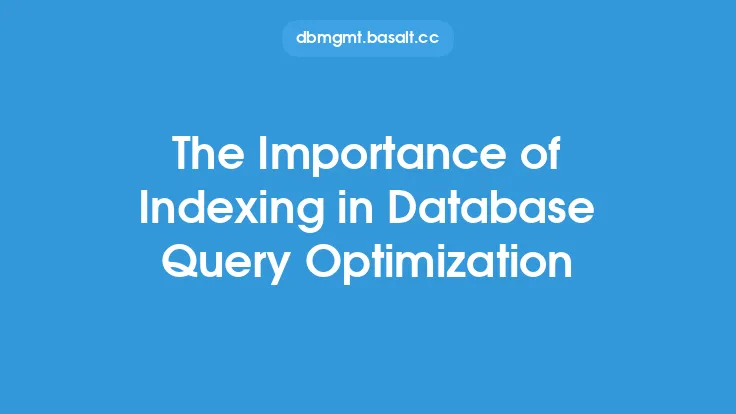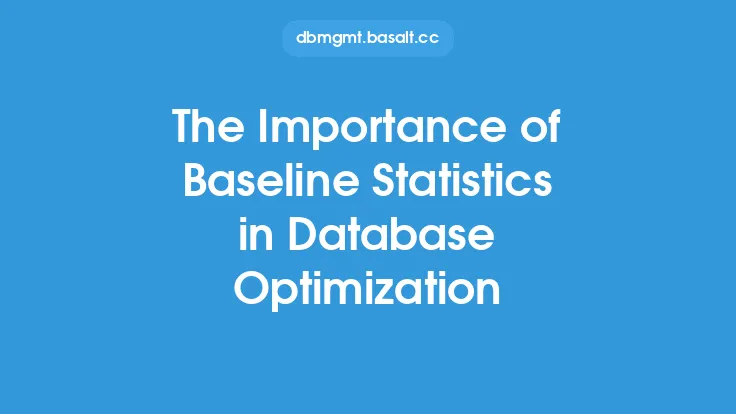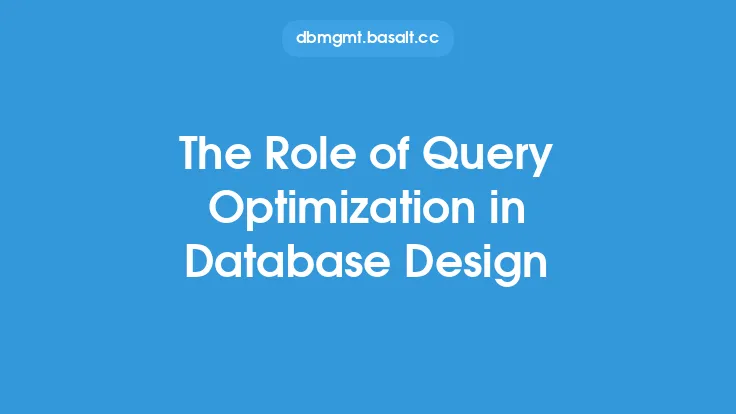Database performance optimization is a critical aspect of ensuring the overall efficiency and reliability of a database management system. One key component of this process is query analysis, which involves examining and understanding the queries that are executed on the database to identify areas for improvement. Query analysis is essential for optimizing database performance, as it allows database administrators to identify and address performance bottlenecks, reduce query execution times, and improve overall system efficiency.
Introduction to Query Analysis
Query analysis is the process of examining and evaluating the queries that are executed on a database to identify areas for improvement. This involves analyzing the query syntax, execution plans, and performance metrics to determine how the query is being executed and where performance bottlenecks may exist. Query analysis can be performed using a variety of tools and techniques, including query profilers, execution plan analyzers, and performance monitoring software. By analyzing queries, database administrators can identify opportunities to optimize query performance, reduce execution times, and improve overall system efficiency.
The Query Optimization Process
The query optimization process involves several steps, including query analysis, indexing, caching, and rewriting. Query analysis is the first step in this process, as it involves examining the query syntax and execution plans to identify areas for improvement. Once performance bottlenecks have been identified, indexing and caching can be used to improve query performance. Indexing involves creating data structures that allow the database to quickly locate and retrieve data, while caching involves storing frequently accessed data in memory to reduce the need for disk I/O. Query rewriting involves modifying the query syntax to improve performance, such as by reducing the number of joins or subqueries.
Query Execution Plans
Query execution plans are a critical component of query analysis, as they provide detailed information about how the query is being executed. An execution plan is a tree-like structure that represents the steps involved in executing a query, including the order of operations, the algorithms used, and the estimated costs. By analyzing the execution plan, database administrators can identify performance bottlenecks, such as slow joins or sorts, and optimize the query accordingly. Execution plans can be obtained using a variety of tools, including query profilers and execution plan analyzers.
Performance Metrics
Performance metrics are another critical component of query analysis, as they provide quantitative information about query performance. Common performance metrics include execution time, CPU usage, memory usage, and disk I/O. By analyzing these metrics, database administrators can identify performance bottlenecks and optimize the query accordingly. For example, if a query is experiencing high CPU usage, it may be necessary to optimize the query to reduce the number of computations required. Performance metrics can be obtained using a variety of tools, including performance monitoring software and query profilers.
Indexing and Caching
Indexing and caching are two techniques that can be used to improve query performance. Indexing involves creating data structures that allow the database to quickly locate and retrieve data, while caching involves storing frequently accessed data in memory to reduce the need for disk I/O. By creating indexes on frequently accessed columns, database administrators can improve query performance by reducing the need for table scans. Similarly, by caching frequently accessed data, database administrators can reduce the need for disk I/O and improve query performance.
Query Rewriting
Query rewriting is another technique that can be used to improve query performance. This involves modifying the query syntax to improve performance, such as by reducing the number of joins or subqueries. Query rewriting can be performed manually or using automated tools, such as query optimizers. By rewriting queries to improve performance, database administrators can reduce execution times and improve overall system efficiency.
Best Practices for Query Analysis
There are several best practices that database administrators can follow to ensure effective query analysis. These include using query profilers and execution plan analyzers to obtain detailed information about query execution, analyzing performance metrics to identify performance bottlenecks, and using indexing and caching to improve query performance. Additionally, database administrators should regularly review and optimize queries to ensure that they are performing optimally. By following these best practices, database administrators can ensure that their databases are performing optimally and that queries are being executed efficiently.
Common Challenges in Query Analysis
There are several common challenges that database administrators may encounter when performing query analysis. These include complex query syntax, large datasets, and limited system resources. To overcome these challenges, database administrators can use a variety of tools and techniques, such as query simplification, data sampling, and resource allocation. By using these tools and techniques, database administrators can effectively analyze queries and optimize database performance.
Conclusion
In conclusion, query analysis is a critical component of database performance optimization. By analyzing queries, database administrators can identify performance bottlenecks, reduce execution times, and improve overall system efficiency. Query analysis involves examining query syntax, execution plans, and performance metrics to identify areas for improvement. By using techniques such as indexing, caching, and query rewriting, database administrators can optimize query performance and improve overall system efficiency. By following best practices and using a variety of tools and techniques, database administrators can ensure that their databases are performing optimally and that queries are being executed efficiently.





